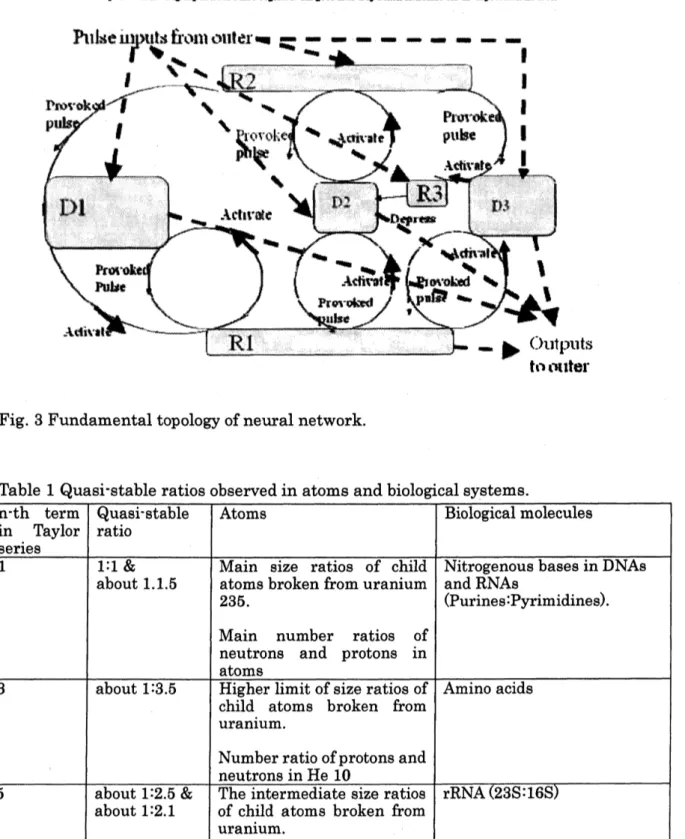A force
theory describing
several
two-particle
systems from
subatomic to
biologic
Ken NAITOH
Faculty
of
Science andEngineeringWasedaUniversity
Aquasi\cdot stabihty concept appliedto
a
momentum conservation law reveals thedynamicsunderlying the magic number and the shell model, i.e., the
reason
why uranium 235mainly leads
to
the weight ratios between asymmetric2:3
and symmetric 1:1 in theresultant
smaller child atoms and
also thereason
why largeratoms such
as
Th havelarger ratios close to 2:3. It reveals the
reason
why the nitrogenous bases inbiologicalbasepairsof nucleicacids,biologicalcellsdivided,liquid dropletsbroken, and stars also
show frequencies in size ratios between 1:1 and about 2:3 (between the golden and
silver
ratios). Then, the $higher\cdot order$of
analysisalso
clarifies the otherratios
over
2:3$\gamma_{k}(\equiv a_{k}/b_{k}[k=1,2])$ of each parcel dependent
on
dimensionless time$\overline{t}_{k}=\sqrt{\frac{8\sigma}{\rho_{L}r_{dk}^{2+m}}}t$ $[k=1,2]$ and the size ratio of the two parcels of
The stochastic governing equation ($\gamma-\epsilon$ equation) having indeterminacy
can
be describedas
$\frac{d^{2}}{It_{i}^{2}}\gamma_{f}=\{[(-\epsilon-\epsilon^{4}+\frac{2}{3}\ovalbox{\tt\small REJECT}_{0j}\gamma_{j}^{-1/3})B_{0i}+\frac{2}{9}\epsilon^{2+m}E_{0i}\epsilon\gamma_{i}^{-4/3}](\frac{d}{It_{i}}\gamma_{i})^{2}$ $+[ \frac{2}{3}\epsilon^{2+m}E_{0i}\gamma_{j^{-1/3}}B_{0j}-\frac{2}{9}\epsilon^{2+m}E_{0i}r_{J^{-4/3}}](\frac{d}{It_{j}}\gamma_{j})^{2}$ $+(- \epsilon-\epsilon^{4}+\frac{2}{3}\epsilon E_{0j}\gamma_{j}^{-1/3})C_{0i}r_{i^{+\frac{2}{3}\epsilon^{2+m}E_{0l}}}^{\frac{52}{33}m}r_{J}^{-1/3}C_{0j}\gamma_{j}^{\frac{52}{33}m}\}/Det$ $+\delta_{st}$ (1)with $[$
for
$i=1,2.j=1,2.i\neq j]$$Det=- \epsilon-\epsilon^{4}+\frac{2}{3}\epsilon^{4}E_{0i}\gamma_{i}^{-1/3}+\frac{2}{3}\epsilon E_{0j}r_{J}^{-1/3},$ $B_{0k}= \frac{1\gamma_{k^{2}}-2}{3\gamma_{k}\gamma_{k^{2}}-1/2}$,
$C_{0k}= \frac{3}{8}\frac{2\gamma_{k^{2m}}-1/\gamma_{k^{m}}-\gamma_{k^{m}}}{\gamma_{k^{2}}-1/2}$
.
and
$E_{0k}=3 \frac{\gamma_{k^{7/3}}}{\gamma_{k^{2}}-1/2}$$[$for
$k=1,2]$where the parameter $\delta_{st}$denotesrandom fluctuation.
The long derivation ofEq. (1) is in Ref. 5 confirmed by the referees, although only the
stochastic term $\delta_{st}$ is not
in Ref.
5. It is also stressed that this systemis not thesimpletwo-body problem of rigid body, because of flexible nonlinear deformations of the
parcels.
We then define the deviation from
a
sphereas
$y_{i}$, which is equal to $\gamma_{i}-1$.
Takingthefirst order ofapproximationintheTaylor series leads to
$\frac{d^{2}y_{i}}{t_{i}^{2}}=[-\frac{2}{3}(3-\epsilon^{3}-2\epsilon^{2+m})(\frac{dy_{i}}{d\overline{t_{f}}})^{2}+3(3-\epsilon^{3})my_{i}-4\epsilon^{1+m}(\frac{dy_{j}}{t_{j}})^{2}+12\epsilon^{1+m}my_{j}]/[3(\epsilon^{3}+1)]$
$+\delta_{st}’$ ,
(2)
where theparameter $\delta_{st}’$
denotes random fluctuation.
[The effect of special theory ofrelativity between
mass
and energy will not influencefor the size ratio of child atoms obtained after the fission processof uranium 235 very
much, because the effect will work
on
both two child atoms atan
identical rate.5. Number ratio
It is also well known that several atoms in nature have the number ratios of
protons and neutrons between 1:1 and 2:3. Here, let
us
examine thereason
why larger15. K. Naitoh, Morphogenic economics. Japan Journal of Industrial and Applied
Mathematics, inpress.
TransEationat motion without deformation
brinQs symmebicdivision.
Deformation ofparcel shape
produces asyrrrnetricdivision. $———-$,
Fig. 1 Asymmetric division due to parcel deformation and symmetric divisions in the
absenceofdeformation.
$14\infty$
$0$ seo 400 $6\infty$ ttOO 1000 Nmber ofpurines
$Biolpalnurk-\dot{\iota}ru$
$0$ $\propto$ $40$ $60$ $\infty$ $1\infty$ $Pr r$
.
M 碗
Fig. 2.Densityratio ofpurines and pyrimidines inRNAs, which is similar to thedensity
ratio ofprotons and neutrons in stable atom
core.
(mRNAsare
between tRNAs andFig. 3 Fundamentaltopologyof neural network.

